Mame-shitogi is a delicious treat found in the Hachinohe Area with an interesting and long history. The word shitogi was originally used to describe what was a precursor to mochi, a common type of rice cake eaten in Japan today. Shitogi was used as an offering food throughout Japan hundreds of years ago.
Today, shitogi still survives in two areas in Japan: the Nanbu region (including the Hachinohe Area and northern Iwate) and in Kyushu. The shitogi found in the Hachinohe Area is different from the shitogi found in Kyushu as the main ingredient is soybeans instead of rice. Historically, the Hachinohe Area could not grow a lot of rice and had to utilize other grains and plants. Therefore, the people of the area made mame-shitogi or soybean-shitogi.
Mame-shitogi usually comes in two colors: black or green. Soybeans are mashed, mixed with rice flour and sugar, and shaped into a small log or oblong cake. It can be eaten as is or sliced and toasted for a warm treat. You can find it in grocery stores and local markets all around the Hachinohe Area, but making it yourself at home is fun and easy.
Notes on adjustments:
The traditional way to make mame-shitogi is to start with dried green soybeans that have been soaked overnight and simmered until soft. Green soybeans rather than regular yellow soybeans are said to be more fragrant and sweet. Using dried green soybeans create a better-tasting final product due to the natural sweetness of the soybeans, and it creates a more complex flavor. But many modern families simply use frozen edamame and add a little bit of sugar to get an equally satisfying result without the extra hassle. Edamame are immature soybeans that are picked while still in the pod. Dried green soybeans can be hard to find, so we recommend making the simpler version that uses edamame. Additionally, dried yellow soybeans or dried black soybeans (not regular black beans) can be used.
Recipe for Mame-Shitogi
Ingredients:
- 1 cup of frozen Edamame (deshelled) or 1/2 cup of dried green soybeans, soaked overnight and simmered (yields a little over 1 cup)
- 1/2 cup of rice flour (regular or glutinous rice flour (a.k.a mochi flour) or a combination of the two)
- A dash of salt
- 1 Tbsp of sugar
Directions:
- If using dried green soybeans, soak beans in a large amount of water overnight. The next day, bring a pot of water to boil, add beans and simmer until just soft (about 40 min~1hr). Strain beans from the pot but reserve about a cup of liquid.
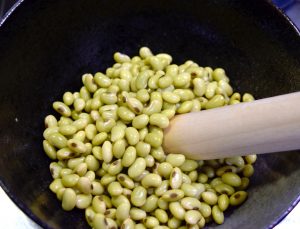
- If using frozen edamame, defrost in a microwave or a pot of boiling water. Drain beans and deshell from pods if needed. Reserve liquids from the beans.
- While beans are still hot, transfer to a mortar and pestle or a food processor. Begin to mash beans (or blitz in the processor) until a coarse meal is formed.
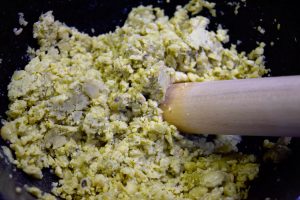
- Continue to mash (or process) beans until a fine paste/meal forms but there are still a few chunks of bean left over. How smooth or course to make the mame-shitogi differs between each family, but most prefer it a little chunky as it adds a more interesting texture.
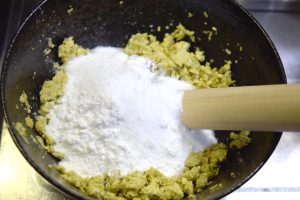
- Using a spoon, mix in the salt, sugar if using, and rice flour.
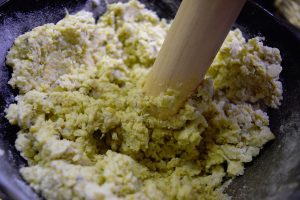
- Slowly mix in a spoonful of the reserved liquid at a time. (If you defrosted your beans in the microwave and there was no liquid, plain warm water can be used instead.) Continue to add more liquid until the mixture just begins to form a dough and starts to come together (the amount of liquid needed varies, but the pictured version took under half a cup). Knead lightly using your hands. The dough may seem a little dry, as resting the dough will allow it to hydrate and come together. Do not add too much water into the dough.
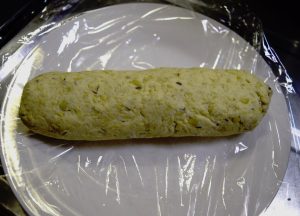
- Form dough into a log, with a diameter of around 1.5 inches (4cm).
- Wrap the dough in plastic wrap and let it rest in the refrigerator for about an hour or two.

- To serve, simply slice the log into half-an-inch (1cm) thick pieces and eat as is. For an even tastier treat, simply toast the slices in a toaster oven using the broil function until they began to brown at the edges and become fragrant.
